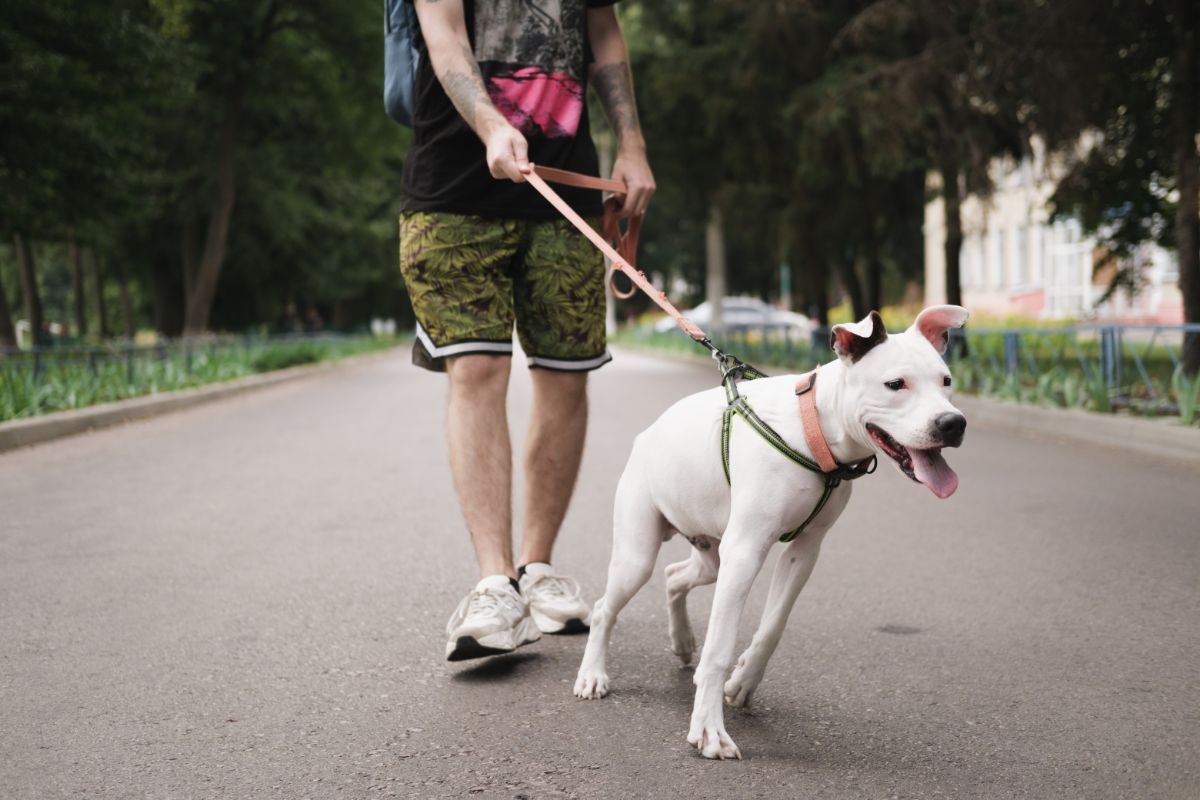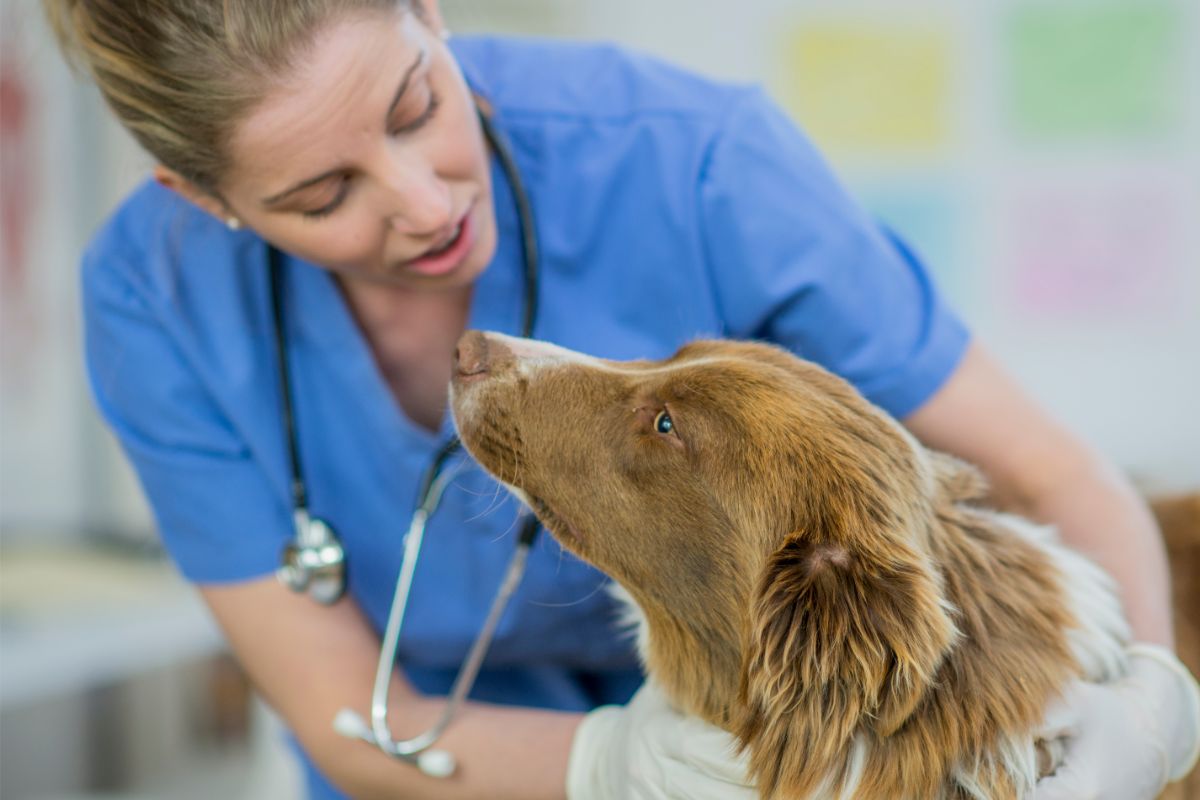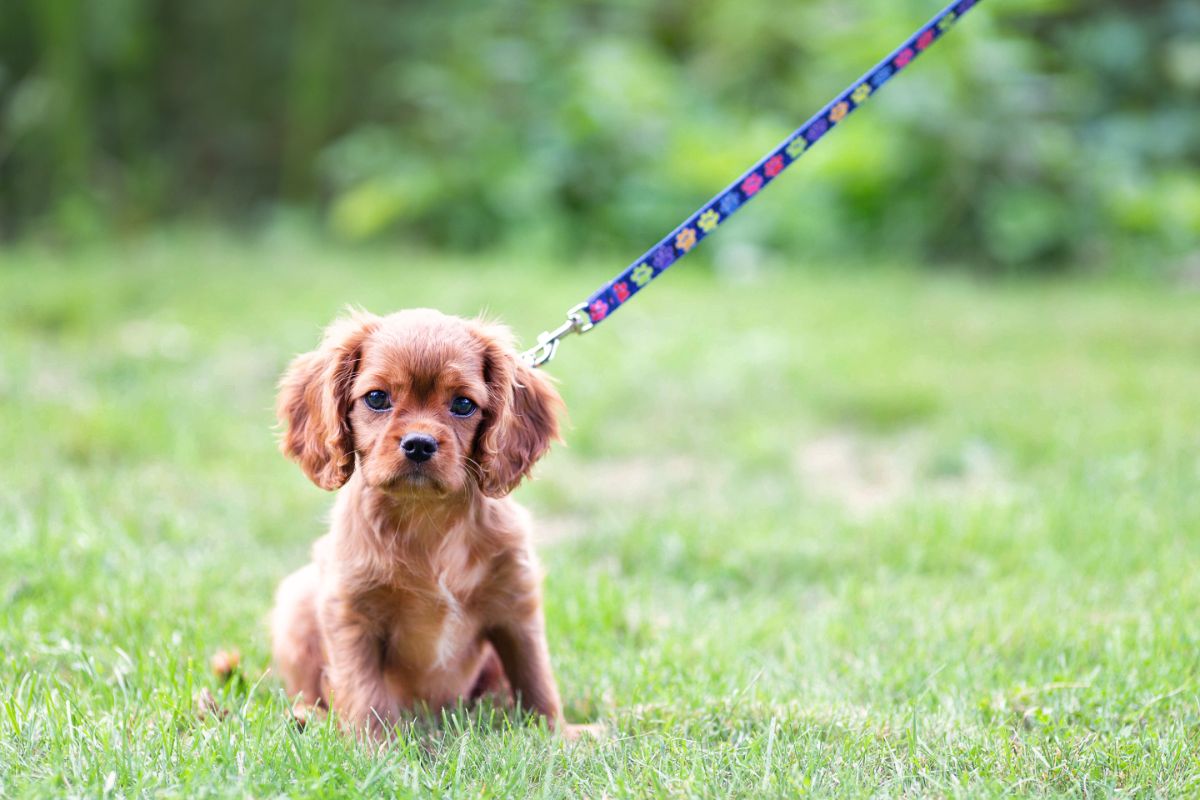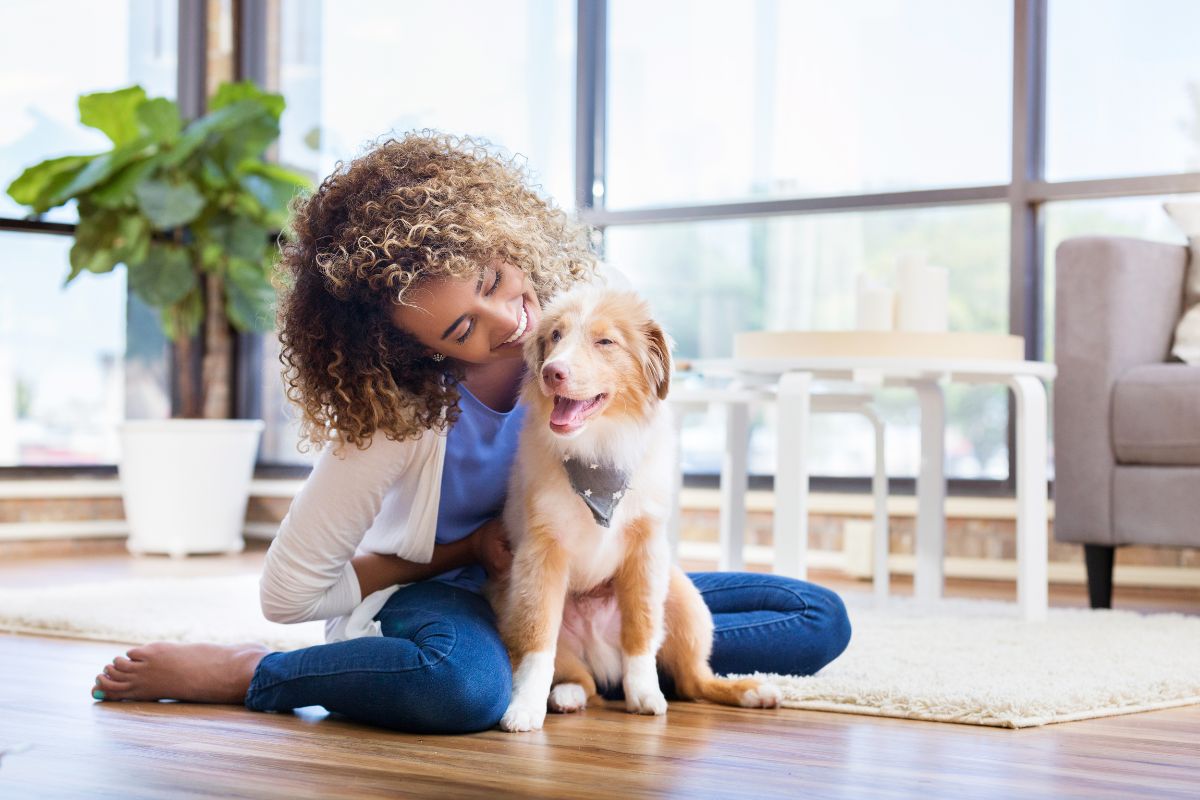Our canine companions truly are our besties.
We would go anywhere with them, and do everything with them if we could. But sometimes, their behavior makes that a little difficult.

If you have been dreaming of relaxed, calm walks with your pooch on a leash, and all they seem to do is lunge and pull, then you don’t have to give up just yet.
Right now, it may seem like your dog is just never going to get it right and is always going to drag you along on walks.
Luckily, we have the answers you have been looking for.
In this guide, we can walk you through why dogs pull, how to teach your dog to walk nicely on a leash, and how to put our tips into practice.
Read on to find out how you too can have relaxing walks with your dog- at your pace, not theirs!
Why Do Dogs Pull On The Leash?
Dogs are naturally very inquisitive creatures. They love exploring and following their noses wherever it takes them. Dogs can also be very excitable, busy, and can long to go see everything.
They just want to explore the world around them.
Certain objects, other people, new places, animals, and other dogs can distract your dog, and make them very excited.
They may pull and lunge to get to the exciting or interesting thing, dragging you along with them.
The most common reason that dogs will pull incessantly on a leash is because pulling is a behavior that they have learned.
At some point, they will have noticed that if they pull hard enough on the leash, they will manage to get forward or progress forward.
Dogs simply want to move quickly and want to engage with their environment. In most cases, humans are much slower than a dog’s natural pace.
Another reason a dog may pull on the leash is due to fear or anxiety-based behavior. When dogs are scared of noises, new environments, or new textures that they are walking on, they may lunge and pull to get away from them as soon as possible.
How To Teach Your Dog To Walk On A Leash Without Pulling
Dogs do not come to us with the prior knowledge of how to walk as humans wish. Dogs just want to run and explore!
So, you have to train your dog to walk appropriately on a leash.
It does not come naturally to them.
Equipment can help you out a lot, but you do have to spend time actually training your dog as this can help them understand what the leash means and how they need to behave.
But, having the right equipment is a great place to start!
Get The Right Equipment
To begin, you will need a harness. Choose one with a front and back clip, so you can add a double-ended lead, or attach a head collar if needed.
If your dog pulls a lot, then this can put a lot of pressure and strain on the neck, which is potentially dangerous for your pooch.
So, invest in a good harness that does not damage the muscles or restrain them too much.
You could also invest in a head collar, or a leash that goes over the nose. This can help you control the dog and direct them, without harming them.
It will take some time to get your canine companion accustomed to these devices, but they do actually work, and they don’t cause any pain.
You will want to avoid collars or leashes that could harm your dog or traumatize them.
Prong collars can make your dog more reactive and anxious when around other animals, which could lead to leash reactivity and dog reactivity, which is even harder to crack.
Always ensure that the experience is a good, positive one, and you will progress much more quickly.
Teach Your Dog To ‘Heel’
Another great way to limit pulling on the leash is to teach your dog to ‘heel’. The ‘heel position’ involves having your dog walking by your side. When they do so, you can reward them.
When your dog knows how to ‘heel’ you can also walk them off-leash and recall them to walk by your side.
This keeps them safe in many situations and gives your dog something mentally stimulating to do.
To train your dog to heel, you may need to start with them on a leash. When they walk by your side, reward them with the hand on that same side.
Take a step or two forward slowly, and guide your dog at your side with the treat near their nose. This should bring them to your side.
Repeat this until your dog walks forward by your side, and repeat the verbal command and rewards.
After a bit of practice, your dog will start to understand the heel command, and you can try it without a leash, or keep the leash on- it is up to you entirely.
Here is an excellent example of teaching your dog the basics of the ‘heel’ in just a few minutes.
This method involves using a slip lead and placing it over the muzzle. This offers much more control as you can guide your dog’s head until they remain by your side.
Know How To Manage Pulling
When you are trying to train your dog not to pull, you need to know how to manage the pulling. Your dog needs to learn that pulling is not going to get them anywhere.
So, when your dog starts to pull and the leash is taut, you can either abruptly stop moving, or change direction.
If stopping works better for you, then the best way to do that is to stop walking as soon as your dog starts to pull, and take a few steps back until your dog is at your side again, and focusing on you.
If you prefer to change direction, then quickly change direction and head the other way. Then, your dog has to follow you and your lead instead.
This is not an easy process, so you may have to do it a few times at home first before doing it out on an actual walk.
Distraction
Dogs may pull on the leash when they are distracted or focused on other things, such as another dog, person, or object.

In these cases, you have to be more interesting to your dog, and you have to work on desensitizing your dog to other distractions.
For instance, if your dog is suddenly excited by something, then you have to bring the focus back to you.
Try taking a toy or ball out with you on walks, and when your dog is struggling to focus on you, you can use the toy to regain their attention.
Play with them, and engage with your dog, and make yourself more interesting.
Alternatively, try using food and positive reinforcement in the same way to regain your dog’s focus.
It is also a good idea to try desensitization. This must be done at a safe distance at first.
For example, if your dog is excited by other animals and other people, try taking them somewhere where these situations will occur, like a dog walking spot.
Then, sit or stand away from these distractions, and reward your dog when they are calm, settled, or focused on you.
This will take a lot of time, so it is worth taking your dog to various different environments and exposing them to these distractions at a safe distance.
When your dog is able to ignore distractions, or not let them overwhelm them, then you can start to practice in closer proximity to these distractions.
Put It Into Practice
With lots of tips and information above, you may be wondering how to put all of this into practice. With a long lead and your dog ready to go, let’s go through it together.
Step One
The first step is to start by standing still, calm, and quiet.
With your dog on a lead, in a controlled environment such as your home or yard, let your dog have the full length of the leash.
Then, remain still if your dog is ignoring you or distracted, and reward your dog when it pays attention or focuses on you.
Always reward your dog with positive reinforcement such as praise and a treat.
Step Two
When you have your dog’s attention, you can start to move forward.
Step forwards, and begin moving off. Use your treats and your voice to engage your dog, or to encourage them to move forwards by staying close to you when walking.
When the leash is loose, reward your dog again with praise and/or treats.
Step Three
The next step comes into play when your dog starts to move away from you or ahead of you.
When the lead is tight, stop walking and remain still, or you can move in another direction.
When the dog pays attention to you and moves back closer towards you, reward and you can move again.
Repeat this step every time your dog starts to lose focus and pulls away from you.
They will begin to learn that this will not get them anywhere, and they will have to stay close to you or by your side if they want to go forwards.
Step Four
Repeat this process multiple times in short, regular sessions.
You may want to begin by doing this in your backyard at first, until your dog starts to understand that you control the leash, and you control the pace of the walk.
Step Five
In your backyard, start placing distractions that could gain your dog’s attention or make them pull. Try placing their favorite toy on the floor.
When your dog tries to pull the leash to get to the toy, stop, and call your dog back to your side and get them to heel.
Then, reward your dog with treats and praise. When they can walk calmly toward the toy, they can have that as the reward.
This teaches your dog that pulling excitedly will slow the process down, and they will not get the toy any quicker.
How Long Does It Take To Train A Dog To Walk Without Pulling?
Training your dog to walk nicely on a leash can be a slow process. You have to practice at first at home, and then implement your training on walks in public.
This can take a number of weeks or months to completely crack the behavior.
For instance, you will need to practice the leash walking and ‘stopping’ technique multiple times before your dog starts to understand that they cannot pull forwards.
If you are desensitizing your dog to certain situations, then this takes time also.
You just have to be patient and take the time to have short, regular sessions where these situations can arise, and your dog can be put to the test.
Final Thoughts
To summarize, the majority of dogs will pull on a leash, especially when they are puppies or in their adolescent stage.
You can limit this behavior with the right equipment, practice, time, and lots of positive reinforcement.
With our tips, your dog can begin to understand that the leash places you in charge, and pulling and lunging will not get them to where they want to be.
- How To Teach Your Puppy Their Name Easily! - July 18, 2023
- Is Your Puppy Counter Surfing? Find Out How To Stop It! - July 18, 2023
- How To Train Your Puppy For Car Rides: Everything You Need To Know - July 18, 2023










